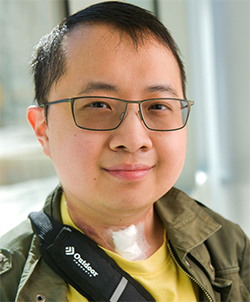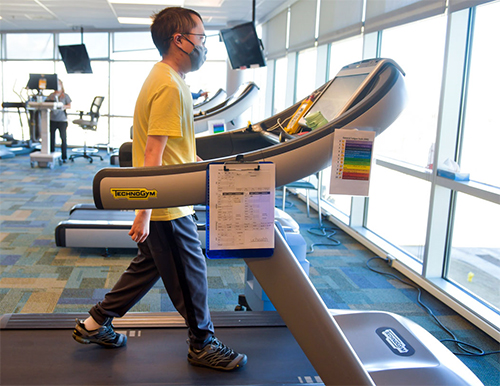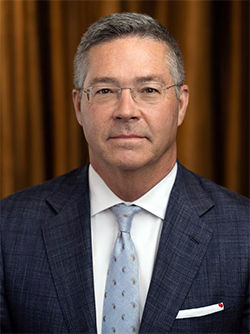DEEP BREATHS
Austin Yang makes travel plans after l ung transplant surgery
Successful surgery gives most lung transplant patients a chance to really breathe again.
It gave Austin Yang his first taste of really breathing. At least as far as he could remember.
Yang fell ill with pneumonia from an adenovirus when he was a baby. It led to a rare disease called bronchiolitis obliterans. You don’t need to know Latin to get the gist: It damaged his lungs and hindered their development.
The son of Hmong refugees from Laos, Yang, now 26, spent most of his life on supplemental oxygen delivered through a tracheostomy tube. An oxygen tank accompanied him through high school in Northglenn and college at the University of Colorado Denver. A ventilator met his oxygen needs as he slept.
Not long after he graduated with an information systems degree in May 2022, Yang’s health deteriorated. By that September, his lungs were failing. He was admitted to Children’s Hospital Colorado, where he had been treated for years and was soon on a mechanical ventilator 24/7.
WAITING FOR SURGERY
In October, as a wave of RSV cases swamped that hospital, he was transferred across the Anschutz Medical Campus to UCHealth University of Colorado Hospital (UCH).

He needed a lung transplant, and UCH is where those happen in Colorado. The hospital’s transplant services team has performed every lung transplant in the state since 1998, including 40 in 2022.
Alice Gray, MD, a University of Colorado School of Medicine critical care medicine specialist and medical director of Lung Transplantation at UCH, quickly recognized that Yang’s lungs were too far gone for even a ventilator. She put him on an ECMO, machine that takes blood from the body, adds oxygen, removes carbon dioxide, and pumps it back in.
“ECMO is very sci-fi,” Yang said later. “But after a while, it was just like, ‘Oh, it’s just another oxygen tank, you know – something I’m used to.’”
Gray also put Yang on the waiting list for a lung transplant. Given Yang’s youth and other factors, his wait might normally have been about a week. But Yang stood four-foot-eleven and weighed around 90 pounds. That limited his options. His days in UCH’s cardiothoracic ICU stretched to two weeks, then three, then four.
At that point, Gray said, “his blood pressure was low, and we were worried he was soon going to become too sick to survive a transplant.”
REPLACING ‘DESTROYED’ LUNGS
Finally, after more than a month, a lung match came through. The morning of Dec. 9, 2022, Yang was rolled into a UCH operating room, where CU School of Medicine cardiothoracic surgeon John Mitchell would perform a double lung transplant.
When he met Yang prior to surgery, Mitchell said, “I was very impressed at how he seemed to be dealing with the incredibly difficult situation he was in – just a tremendous amount of fortitude through the whole thing.”
Early in the procedure, Mitchell saw that this would be one of the most challenging of the hundreds of lung transplants he had performed. Not only were Yang’s lungs “basically destroyed,” but also previous pleurodesis procedures to stop the lungs from collapsing had brought scarring that essentially cemented Yang’s lungs to his chest walls.
“So, chiseling out everything safely for him was really difficult,” Mitchell said.
Twelve hours later, Mitchell and the surgical team had finished their work. Yang returned to the cardiothoracic ICU for a couple of days, underwent a routine follow-up procedure to remove blood clots, and was home two weeks later.

Austin Yang on the treadmill in UCHealth University of Colorado Hospital’s pulmonary rehabilitation center two-and-a-half months after surgery. Before the transplant, he could barely walk without supplemental oxygen. Photo by Cyrus McCrimmon.
The tracheostomy tube, the oxygen tank by day and the ventilator by night – all were now things of the past for him. In their place were antirejection drugs.
He was doing pulmonary rehabilitation at UCH within two months of surgery – on the treadmill and other cardio machines as well as doing strength work, all of it unimaginable before.
“I have so much more energy,” Yang said.
PLANNING TO TRAVEL LIGHTLY
He looks forward to job hunting, perhaps in cybersecurity, ideally in IT at Children’s Hospital Colorado.
“I’ve been there so long that I want to repay their kindness,” he said.
He also looks forward to traveling to places like Japan, South Korea, Taiwan, and Canada. Before, even if he had the energy, he would have to lug oxygen, a ventilator, and sterilized water for the ventilator’s humidifier. Now, he can travel light, he says.
“Now, it’s just packing clothes, a few medications, that’s it,” Yang said.
He concedes that the prospect of undergoing a transplant was “a scary thing.” But it was, at the same time “a very joyful thing, bringing about a new life, if at the cost of an unfortunate passing of someone else,” he said.
Mitchell may have performed the essential act of replacing Yang’s failing lungs with healthy ones, but he stressed the importance of the team’s broader efforts. Gray’s care kept Yang strong enough to withstand the transplant. Critical care doctors and nurses sustained Yang for weeks in the ICU. Anesthesiologists managed him during the operation. Perfusionists kept an eye on Yang’s ECMO.
“It’s a big group effort – that’s so important,” Mitchell said.

There are no guarantees for lung transplant patients. There’s a 45% rejection rate in the five years post-transplant. But Mitchell is optimistic.
“If you look at his X-rays, it’s just unbelievable. I think overall, he’s off to a really good start, especially given what dire straits he was in prior to the operation,” Mitchell said. “It’s really gratifying.”
This article was originally published by UCHealth in March 2023.